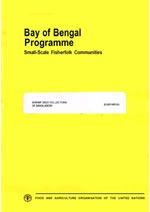
WORKING PAPERS - BOBP/WP/63
 |
WORKING PAPERS - BOBP/WP/63 Shrimp Seed Collectors of Bangladesh |
|
Executing Agency: FOOD AND AGRICULTURE ORGANIZATION OF THE UNITED NATIONS Funding Agency: SWEDISH INTERNATIONAL
DEVELOPMENT AUTHORITY Development of Small-Scale Fisheries in the Bay of Bengal. Madras, India, October 1990 |
| The designations employed and the presentation of material in this publication do not imply the expression of any opinion whatsoever on the part of the Food and Agriculture Organization of the United Nations concerning the legal status of any country, territory, city or area or of its authorities, or concerning the delimitation of its frontiers or boundaries. |
All rights reserved. Reproduction and dissemination of material in this information product for educational or other non-commercial purposes are authorized without any prior written permission from the copyright holders provided the source is fully acknowledged. Reproduction of material in this information product for resale or other commercial purposes is prohibited without written permission of the copyright holders. Applications for such permission should be addressed to the Chief, Publishing and Multimedia Service, Information Division, FAO, Viale delle Terme di Caracalla, 00100 Rome, Italy or by email to [email protected]
© FAO 2004
|
Thousands of people — men, women and children — in coastal areas of Bangladesh, make a living collecting shrimp fry: some 40,000 in Cox’s Bazaar, nearly three times as many in Satkhira and Khulna. Despite the role of these people in sustaining the shrimp industry which generates foreign exchange earnings, they remain poor and under-privileged. This paper is based on a socio-economic study of the shrimp fry collectors undertaken in 1987 by a voluntary agency, UBINIG (Policy Research for Development Alternatives). The aim is to obtain information and discover strategies to improve the lot of the shrimp seed collectors. The study, and this paper which describes it, were sponsored by the BOBP’s project “Small-scale fisherfolk communities in the Bay of Bengal,” GCP/RAS/118/MUL. The project is funded by SIDA (Swedish International Development Authority) and DANIDA (Danish International Development Agency) and executed by the FAO (Food and Agriculture Organization of the United Nations). The project covers seven countries around the Bay of Bengal (Bangladesh, India, Indonesia, Malaysia, Maldives, Sri Lanka, Thailand). The main goals of the project, which commenced in 1987, are to develop, demonstrate and promote new technologies and methodologies to improve the conditions of small-scale fisherfolk communities in member-countries. |
1. INTRODUCTION
2. SHRIMP FRY COLLECTION
3. OFF-SEASON EMPLOYMENT
4. WOMEN IN FRY CATCHING
5. CHILDREN IN FRY CATCHING
6. THE SHRIMP FRY TRADERS
7. WHAT IS TO BE DONE?
APPENDICES
1. Methodology
2. The Villages Selected
3. Characteristics of the Sample
4. Tables
5. Glossary
6. The Calendar
PUBLICATIONS OF THE BAY OF BENGAL PROGRAMME